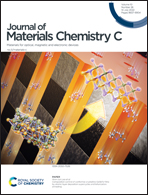1,7/8-Substituted isoquinoline derivatives: position isomerism caused by HIO3-induced dehydrogenation and solid-state fluorescence stimulus-responsive properties†
Abstract
A series of 1,7/8-substituted isoquinolines are designed and synthesized via the dehydrogenation reactions of 7,8-dihydroisoquinolines in the presence of iodic acid. Interestingly, the dehydrogenation products are found to be closely related to the electronic effect of the substituted groups at positions 1 and 8. A hydrogen atom and a cyano group lead to 1,8-substituted isoquinolines, and the N,N-dimethylamino unit with strong electron-donating ability results in 1,7-substituted isoquinolines, while the methoxy group with moderate electron-donating ability might simultaneously cause the generation of these two kinds of isoquinolines. These results reveal that the strong electron-donating ability of the substituent is conducive to the formation of a rearrangement product. These 1,7/8-substituted isoquinolines with twisted molecular conformations exhibit dual-state emissions. Although all the isoquinolines show a morphological change from a crystalline state to an amorphous state under external pressure, only SQ-MO-7 and SQ-DMA-7 display outstanding MFC activities. Their hypsochromic MFC activities are demonstrated to be attributed to that these two compounds have more flat molecular conformations in the crystalline state compared with other isoquinolines, which make them have enough deformation space and obtain more twisted conformations. Furthermore, all these derivatives exhibit reversible solid-state acidochromic activities caused by the change of intramolecular charge transfer originating from the protonation–deprotonation process.



 Please wait while we load your content...
Please wait while we load your content...